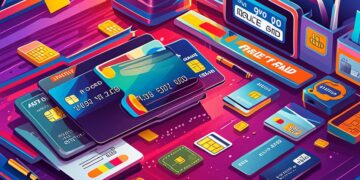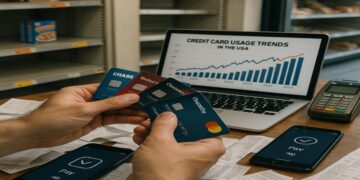Credit Cards and Security: How to Protect Your Financial Information in a Digital World

Importance of Credit Card Security in the Digital Age
As e-commerce continues to expand and online transactions become an integral part of everyday life, safeguarding your financial information has become paramount. The convenience of shopping online or managing finances digitally comes with inherent risks; each year, millions of Americans fall prey to credit card fraud and identity theft. The repercussions of such breaches extend beyond mere financial loss, often resulting in significant emotional distress and lasting consequences for victims. With a proactive stance and effective security measures, individuals can navigate the complexities of the digital landscape more safely.
Essential Practices for Enhancing Credit Card Security
Adopting robust security practices can greatly mitigate the risk of fraud. Below are some vital measures that individuals should consider to enhance their credit card security:
- Use Strong Passwords: Crafting complex passwords is essential in protecting your online accounts. A robust password should include a mix of uppercase and lowercase letters, numbers, and special characters. Aim for at least 12 characters and avoid obvious choices—such as birthdates or common phrases. Regularly updating these passwords is also advisable to deter unauthorized access.
- Enable Two-Factor Authentication: Implementing two-factor authentication (2FA) can dramatically increase security. This method requires not only a password but also a secondary form of verification, which could be a text message with a unique code or a biometric scan. This additional step makes it significantly more challenging for fraudsters to gain access even if they have your password.
- Monitor Your Accounts: Staying vigilant by regularly reviewing bank statements and online transaction histories is crucial. Look for unfamiliar transactions, and don’t hesitate to report any discrepancies to your bank immediately. Setting up alerts for transactions can also provide timely notifications of activity on your accounts.
- Shop on Secure Websites: Ensure that you only shop on secure websites that utilize encryption technology. Look for URLs that begin with “https://” and check for security badges or trust seals from reputable organizations during checkout. This guarantees that your data is being transmitted securely.
- Limit Information Sharing: Be mindful of the personal information you disclose online. Confirm that you’re providing sensitive data to trusted sources, and whenever possible, avoid sharing details that are not necessary for transactions or online registrations.
Understanding the Financial Implications
The financial impact of security breaches can be staggering. According to the Federal Trade Commission, credit card fraud is among the most reported financial scams in the United States. Each year, millions is lost to fraudulent transactions, affecting not only the immediate victims but also impacting overall consumer confidence in the financial system. The emotional toll can be equally substantial, as victims often experience anxiety and stress related to the potential loss of hard-earned resources.
Recognizing the risks associated with online transactions and proactively managing credit card security measures can shield not only your financial assets but also foster a sense of security in a rapidly evolving digital marketplace. By embracing comprehensive security practices, you can protect against becoming another statistic in the realm of financial fraud and maintain peace of mind in your digital interactions.
DISCOVER MORE: Click here to learn how to save on insurance premiums
Essential Practices for Enhancing Credit Card Security
Adopting robust security practices can greatly mitigate the risk of fraud. Below are some vital measures that individuals should consider to enhance their credit card security:
- Use Strong Passwords: Crafting complex passwords is essential in protecting your online accounts. A robust password should include a mix of uppercase and lowercase letters, numbers, and special characters. Aim for at least 12 characters and avoid obvious choices—such as birthdates or common phrases. Regularly updating these passwords is also advisable to deter unauthorized access.
- Enable Two-Factor Authentication: Implementing two-factor authentication (2FA) can dramatically increase security. This method requires not only a password but also a secondary form of verification, which could be a text message with a unique code or a biometric scan. This additional step makes it significantly more challenging for fraudsters to gain access, even if they have your password.
- Monitor Your Accounts: Staying vigilant by regularly reviewing bank statements and online transaction histories is crucial. Look for unfamiliar transactions, and don’t hesitate to report any discrepancies to your bank immediately. Setting up alerts for transactions can also provide timely notifications of activity on your accounts.
- Shop on Secure Websites: Ensure that you only shop on secure websites that utilize encryption technology. Look for URLs that begin with “https://” and check for security badges or trust seals from reputable organizations during checkout. This guarantees that your data is being transmitted securely.
- Limit Information Sharing: Be mindful of the personal information you disclose online. Confirm that you’re providing sensitive data to trusted sources, and whenever possible, avoid sharing details that are not necessary for transactions or online registrations.
Understanding the Financial Implications
The financial impact of security breaches can be staggering. According to the Federal Trade Commission, credit card fraud is among the most reported financial scams in the United States. Each year, millions is lost to fraudulent transactions, affecting not only the immediate victims but also impacting overall consumer confidence in the financial system. The emotional toll can be equally substantial, as victims often experience anxiety and stress related to the potential loss of hard-earned resources.
Recognizing the risks associated with online transactions and proactively managing credit card security measures can shield not only your financial assets but also foster a sense of security in a rapidly evolving digital marketplace. By embracing comprehensive security practices, you can protect against becoming another statistic in the realm of financial fraud and maintain peace of mind in your digital interactions.
DISCOVER: Click here to learn how to pay off your credit card debt faster
The Role of Technology in Credit Card Security
In the digital age, technology plays a pivotal role in safeguarding credit card information. Various innovative solutions have emerged, offering consumers enhanced security and better control over their financial data. Here are some key technological advancements contributing to credit card security:
- EMV Technology: EMV cards, which incorporate embedded microchips, have significantly improved transaction security compared to traditional magnetic stripe cards. These chips generate unique transaction codes, making it nearly impossible for fraudsters to duplicate cards. The widespread adoption of EMV technology in the United States has helped reduce in-person credit card fraud considerably.
- Virtual Credit Cards: Many financial institutions now offer virtual credit card numbers that allow consumers to make online purchases without exposing their actual credit card information. These temporary card numbers can be used for a single transaction or for a limited time, minimizing the risk of unauthorized access to your primary account.
- Mobile Wallets: Mobile payment systems, such as Apple Pay and Google Wallet, offer an additional layer of security through tokenization. When users make a purchase, their actual card number is not transmitted; instead, a unique digital token is sent, ensuring that sensitive data remains protected. This method not only protects user information but also offers convenience and speed during transactions.
- Fraud Detection Algorithms: Financial institutions increasingly rely on advanced fraud detection systems powered by artificial intelligence. These algorithms analyze transaction patterns in real-time to identify and flag any suspicious activity. Immediate alerts are sent to consumers and banks when anomalies are detected, enabling rapid responses to potential fraud.
- Biometric Authentication: Integrating biometric verification methods such as fingerprint scanning and facial recognition has revolutionized the way consumers access their accounts. This multi-layer authentication process ensures that only authorized users can complete transactions, thus enhancing overall security.
The Importance of Security Updates
Consistently updating security software is critical in maintaining a secure environment for credit card transactions. Cyber threats are ever-evolving, with hackers continually developing new methods to bypass defenses. Utilizing up-to-date antivirus software and operating systems is a fundamental practice for any device used for online transactions. Additionally, ensuring that credit card applications and financial management tools are regularly updated with the latest security patches helps to minimize vulnerabilities.
Consumers should be proactive about software updates on their devices, as most updates include essential fixes to known security flaws. Moreover, subscribers of credit monitoring services can receive alerts about potential data breaches involving their personal information. This allows individuals to take the necessary steps—such as freezing credit or altering passwords—before any damage occurs.
It is also prudent to educate oneself about the evolving landscape of credit card security. Staying informed regarding new threats and protective measures fosters a proactive mindset toward financial security. By leveraging the latest technologies and maintaining updated software, individuals can significantly enhance their ability to protect their financial information.
DIVE DEEPER: Click here to learn more
Conclusion
In a rapidly advancing digital landscape, the importance of securing credit card information cannot be overstated. As consumers increasingly rely on electronic transactions, understanding the diverse security measures available is crucial. With effective solutions like EMV technology, virtual credit cards, and mobile wallets, users can greatly enhance their defense against potential threats. For instance, EMV technology, which utilizes microchips embedded in credit cards, significantly reduces the risk of card fraud by making it difficult for counterfeiters to replicate cards. Through dynamic data authentication, EMV cards provide an additional layer of security that traditional magnetic stripe cards lack.
Additionally, virtual credit cards offer a valuable alternative for online shopping. These disposable card numbers can be generated through banking apps and services, allowing consumers to use a temporary number instead of their actual credit card details, thus minimizing the chance of exposure. Similarly, mobile wallets, such as Apple Pay and Google Wallet, provide secure, encrypted transactions that leverage tokenization, further protecting users from unauthorized access to their sensitive information.
Furthermore, leveraging advanced systems such as fraud detection algorithms and biometric authentication equips individuals with powerful tools to safeguard their financial data. Fraud detection algorithms analyze transaction patterns in real-time, enabling immediate alerts when suspicious activities are detected. Meanwhile, biometric authentication methods, such as fingerprint recognition or facial recognition, enhance security by ensuring that only the legitimate user can authorize transactions.
However, technology alone is not sufficient. A vigilant mindset towards security practices plays a vital role in protecting personal information. Regularly updating security software, utilizing credit monitoring services, and remaining informed about the latest threats empowers consumers to remain ahead of emerging challenges. For example, by setting up alerts for unusual spending behavior or authentication attempts, consumers can proactively safeguard their accounts from potential breaches.
Ultimately, the challenge of safeguarding credit card information is an ongoing endeavor. By combining state-of-the-art technology with proactive personal security measures, consumers can enjoy the convenience of digital payments while minimizing vulnerabilities. Therefore, a commitment to education and vigilance will serve as the bedrock for securely navigating financial transactions in this digital age. The landscape continues to evolve; staying informed and adapting to new security practices is essential for anyone engaged in digital commerce.

Beatriz Johnson is a seasoned financial analyst and writer with a passion for simplifying the complexities of economics and finance. With over a decade of experience in the industry, she specializes in topics like personal finance, investment strategies, and global economic trends. Through her work on True Metronome, Beatriz empowers readers to make informed financial decisions and stay ahead in the ever-changing economic landscape.





